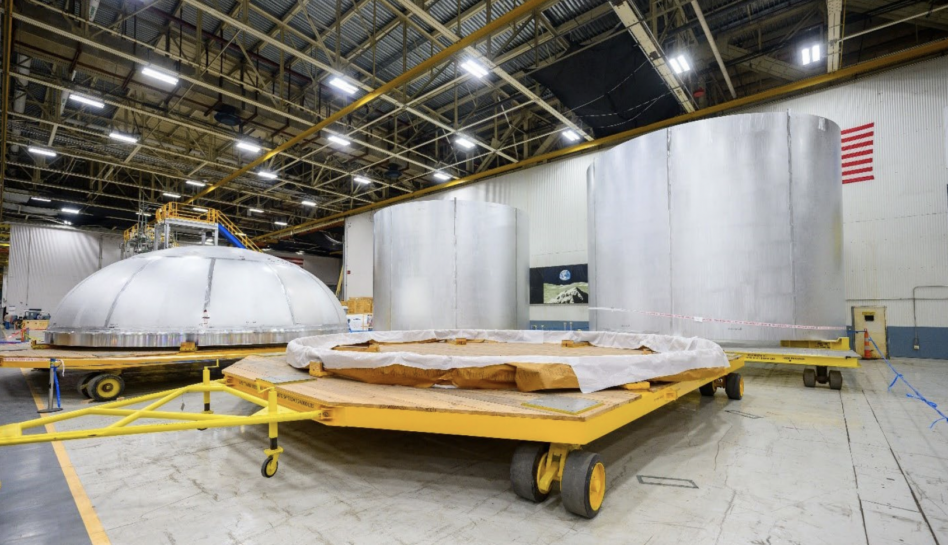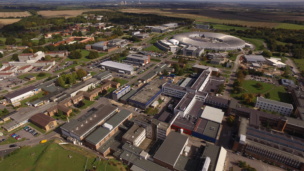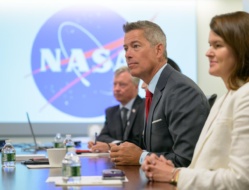Over the past two weeks, two federal watchdogs—the OIG and the GAO—released separate reports highlighting critical issues with two Artemis IV vehicles: Gateway and SLS Block 1B, the upgraded SLS variant.
The reports come at a time of increased legislative and agency prioritization of the Artemis program, often at the expense of science missions, as flight timelines begin to creep closer.
The Artemis IV mission is slated to launch in September 2028. The mission will be the second lunar landing and the first to use Gateway, a lunar-orbiting station designed for research, habitation, and jumping-off point for Moon landings.
Nine months before the Artemis IV astronauts arrive, in December 2027, NASA plans to launch the first two Gateway modules aboard a Falcon Heavy:
- The Power and Propulsion Element (PPE) module
- The Habitation and Logistics Outpost (HALO) module
The total cost of the initial Gateway capability is $5.3B, according to a US Government Accountability Office (GAO) report published July 31.
Once the PPE and HALO Gateway modules are properly situated in a near-rectilinear halo orbit around the Moon, it will begin playing host to three separate transport vehicles.
- Dragon XL, for cargo resupply
- Starship HLS, for lunar landing visits
- Orion, for crew transport to and from Earth
The three vehicles extending from each side of Gateway have varying mass and shapes, creating a lopsided stack, almost resembling an old-school Bop It! toy (a reference for all the fellow 90’s babies out there).
That disproportionate mass distribution is creating problems for station control.
The GAO identified stack controllability as the Gateway’s biggest constraint, potentially impacting vehicle orientation and docking.
The primary culprit here is Starship, a vehicle with mass 18 times greater than NASA’s original controllability parameters. To mitigate the issue, NASA is working through two options:
- Sharing thrusting responsibilities with the other vehicles
- Altering the PPE control algorithm
SLS Block 1B
As watchdog reports go, the GAO’s critiques of Gateway were relatively mild.
NASA’s Office of Inspector General (OIG) report, published Aug. 8, on Boeing’s management of SLS Block 1B development was much more scathing.
SLS Block 1B is an upgraded SLS variant that will be used to carry four astronauts to Gateway for the Artemis IV mission.
The report harshly criticized Boeing, blaming the numerous programmatic delays, quality control issues, and cost overruns on a “lack of a sufficient number of trained and experienced aerospace workers at Boeing.”
Face-lift: NASA is upgrading SLS to enable further mission complexity:
- The upgraded Block 1B will increase SLS payload capability to the Moon by 40%, from 27 metric tons to 38 metric tons.
- The increased payload capacity will allow SLS to launch both the Orion capsule and I-HAB, a habitat built by ESA and JAXA, on a single launch.
With each launch costing ~$2B, an upgraded SLS that can pack more weight on each flight will help widen the mission scope and improve efficiency. But, as the OIG pointed out, getting from Block 1 to Block 1B has been a struggle.
Boeing’s work on Block 1B has seen an abnormally high number of Corrective Action Requests, which have not been adequately addressed, the report found.
“Boeing’s process to address deficiencies to date has been ineffective, and the company has generally been nonresponsive in taking corrective actions when the same quality control issues reoccur,” the OIG wrote in its report.
Block 1B Upgrades: The primary upgrade to SLS is its new Boing-built upper stage, the Exploration Upper Stage (EUS).
- The new stage will consist of four RL10 engines, up from one RL10 engine in Block I’s Interim Cryogenic Propulsion Stage upper stage.
The cost estimates to develop the EUS upper stage have increased from $962M to $2.8B.
In total, the watchdog said $3B has been spent on Block 1B development to date, with projected costs projected to escalate to $5.7B by the time it launches in 2028. The development cost is on top of the $24B NASA has already invested in SLS Block 1 development.
The OIG bluntly criticized Boeing’s inadequate workforce, blaming it for the ongoing issues.
The report cites one example of improper welding on a liquid oxygen fuel tank dome, which caused a seven-month delay in the EUS completion. Boeing officials acknowledge the deficiencies in its workforce, citing difficulty in attracting aerospace workers due to its Michoud facility’s geographic location and lower pay than competitors.
The Boeing takedown comes at a particularly trying time for the aerospace giant with its Starliner spacecraft sitting in limbo at the ISS and myriad issues in its aircraft division.




